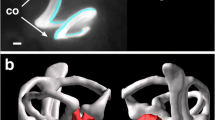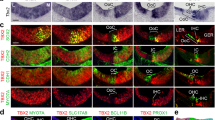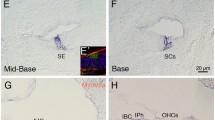Abstract
Mechanosensory hair cells of the vertebrate cochlea offer an excellent developmental system to study cell-fate specification, and to gain insight into the many human neurological deficits which result in a hearing loss, by affecting primarily the hair cells. Therefore, there is great interest in studying the molecular mechanisms that regulate their specification and differentiation.
Recent studies, based mostly on loss-of-function experiments that target the role of Notch signaling and basic helix-loop-helix genes in inner-ear development have indicated that they can regulate mechanosensory hair cell-fate specification and their initial differentiation.
Similar content being viewed by others
References
Van De Water T. R. (1983) Embryogenesis of the inner ear: in vitro studies, in Development of Auditory and Vestibular Systems. (Romand, R., ed.), Academic Press, NY, pp. 337–374.
Fritzsch B., Barald K. F., Lomax M. I. (1998) Early development of the vertebrate ear, in Development of the Auditory System. (Rubel E. W., Popper A. N., and Fay R. P., eds.), Springer-Verlag, NY, pp. 80–145.
Fekete D. M. (1996) Cell fate specification in the inner ear. Curr. Opin. Neurobiol. 6, 533–541.
Torres M. and Giraldez F. (1998) The development of the vertebrate inner ear. Mech. Dev. 71, 5–21.
Rinkwitz S., Bober E., and Baker R. (2001) Development of the vertebrate inner ear. Ann. NY Acad. Sci. 942, 1–14.
Fekete D. M. (1999) Development of the vertebrate ear: insights from knockouts and mutants. Trends Neurosci. 22, 263–269.
Cantos R., Cole L. K., Acampora D., Simeone A., and Wu D. K. (2000) Patterning of the mammalian cochlea. Proc. Natl. Acad. Sci. USA 97, 11,707–11,713.
Represa J., Frenz D. A., and Van De Water T. R. (2001) Genetic patterning of embryonic inner ear development. Acta. Otolaryngol. 120, 5–10.
Fekete D. M. and Wu, D. K. (2002) Revisiting cell fate specification in the inner ear. Curr. Opin. Neurobiol. 12, 35–42.
Ohnuma S., Philpott A., and Harris W. A. (2001) Cell cycle and cell fate in the nervous system. Curr. Opin. Neurobiol. 11, 66–73.
Dyer M. A. and Cepko C. L. (2001) Regulating proliferation during retinal development. Nat. Rev. Neurosci. 2, 333–342.
Pirvola U., Ylikoski J., Trokovic R., Hebert J. M., McConnell S., and Partanen J. (2002) FGFR1 is required for the development of the auditory sensory epithelium. Neuron 35, 671–680.
Ruben R. J. (1967) Development of the inner ear of the mouse: a radioautographic study of terminal mitosis. Acta. Otolaryngol. Suppl. 220, 1–44.
Chen P. and Segil N. (1999) p27(Kip1) links cell proliferation to morphogenesis in the developing organ of Corti. Development 126, 1581–1590.
Lowenheim H., Furness D. N., Kil J, Zinn C., Gultig K., Fero M. L., Frost D., Gummer A. W., Roberts J. M., Rubel E. W., Hackney C. M., and Zenner H. P. (1999) Gene disruption of p27(Kip1) allows cell proliferation in the postnatal and adult organ of Corti. Proc. Natl. Acad. Sci. USA 96, 4084–4088.
Chen P., Johnson J. E., Zoghbi H. Y., and Segil N. (2002) The role of Math1 in inner ear development: Uncoupling the establishment of the sensory primordium from hair cell fate determination. Development 129, 2495–2505.
Fritzsch B., Beisel K. W., and Bermingham N. A. (2000) Developmental evolutionary biology of the vertebrate ear: conserving mechanoelectric transduction and developmental pathways in diverging morphologies. NeuroReport 11, R35–44.
Eddison M., Le Roux I., and Lewis J. (2000) Notch signaling in the development of the inner ear: lessons from Drosophila. Proc. Natl. Acad. Sci. USA 97, 11,692–11,699.
Modolell J. (1997) Patterning of the adult peripheral nervous system of Drosophila. Perspect. Dev. Neurobiol. 44, 285–296.
Artavanis-Tsakonas S., Rand M. D., and Lake R. J. (1999) Notch signaling: Cell fate control and signal integration in development. Science 284, 770–776.
Bermingham N. A., Hassan B. A., Price S. D., Vollrath M. A., Ben-Arie N., Eatock R. A., Bellen H. J., Lysakowski A., and Zoghbi H. Y. (1999) Math1: an essential gene for the generation of inner ear hair cells. Science 284, 1837–1841.
Shailam R., Lanford P. J., Dolinsky C. M., Norton C. R., Gridley T., and Kelley M. W. (1999) Expression of proneural and neurogenic genes in the embryonic mammalian vestibular system. J. Neurocytol. 28, 809–819.
Ben-Arie N., Hassan B. A., Bermingham N. A., Malicki D. M., Armstrong D., Matzuk M., Bellen H. J., and Zoghbi H. Y. (2000) Functional conservation of atonal and Math1 in the CNS and PNS. Development 127, 1039–1048.
Lanford P. J., Shailam R., Norton C. R., Gridley T., and Kelley M. W. (2000) Expression of Math1 and Hes5 in the cochleae of wildtype and Jag2 mutant mice. JARO 1, 161–171.
Adam J., Myat A., Le Roux I., Eddison M., Henrique D., Ish-Horowicz D., Lewis J. (1998) Cell fate choices and the expression of Notch, Delta and Serrate homologues in the chick inner ear: parallels with Drosophila sense organ development. Development 125, 4645–4654.
Lewis A. K., Frantz G. D., Carpenter D. A., de Sauvage F. J., and Gao W. Q. (1998) Distinct expression patterns of notch family receptors and ligands during development of the mammalian inner ear. Mech. Dev. 78, 159–163.
Lanford P. J., Lan Y., Jiang R., Lindsell C., Weinmaster G., Gridley T., and Kelley M. W. (1999) Notch signalling pathway mediates hair cell development in mammalian cochlea. Nat. Genet. 21, 289–292.
Morrison A., Hodgetts C., Gossler A., Hrabe de Angelis M., and Lewis J. (1999) Expression of Delta1 and Serrate1 (Jagged1) in the mouse inner ear. Mech Dev. 84, 169–172.
Zine A., Van De Water T. R., and de Ribaupierre F. (2000) Notch signaling regulates the pattern of auditory hair cell differentiation in mammals. Development 127, 3373–3383.
Zhang N., Martin G. V., Kelley M. W., and Gridley T. (2000) A mutation in the Lunatic fringe gene suppresses the effects of a Jagged2 mutation on inner hair cell development in the cochlea. Curr. Biol. 10, 659–662.
Edlund T. and Jessell T. M. (1999) Progression from extrinsic to intrinsic signaling in cell fate specification: a view from the nervous system. Cell 96, 211–224.
Zheng J. L. and Gao W. Q. (2000) Overexpression of Math1 induces robust production of extra hair cells in postnatal rat inner ears. Nat. Neurosci. 3, 580–586.
Jarman A. P., Grau Y., Jan L. Y., and Jan Y. N. (1993) Atonal is a proneural gene that directs chordotonal organ formation in Drosophila peripheral nervous system. Cell 73, 1307–1321.
Jarman A. P. and Ahmed I. (1998) The specificity of proneural genes in determining Drosophila sense organ identity. Mech. Dev. 76, 117–25.
Hassan B. A. and Bellen H. J. (2000) Doing the MATH: is the mouse a good model for fly development? Genes Dev. 14, 1852–1865.
Ma Q., Anderson D. J., and Fritzsch B. (2000) Neurogenin 1 null mutant ears develop fewer, morphologically normal hair cells in smaller sensory epithelia devoid of innervation. JARO 1, 129–143.
Kim W. Y., Fritzsch B., Serls A., Bakel L. A., Huang E. J., Reichardt L. F., Barth D. S., and Lee J. E. (2001) NeuroD-null mice are deaf due to a severe loss of the inner ear sensory neurons during development. Development 128, 417–426.
Liu M., Pereira F. A., Price S. D., Chu M. J., Shope C., Himes D., Eatock R. A., Brownell W. E., Lysakowski A., Tsai M. J. (2000) Essential role of BETA2/NeuroD1 in development of the vestibular and auditory systems. Genes Dev. 14, 2839–2854.
Lee J. E. (1997) Basic helix-loop-helix genes in neural development. Curr. Opin. Neurobiol. 7, 13–20.
Anderson D. J. (1999) Lineages and transcription factors in the specification of vertebrate primary sensory neurons. Curr. Opin. Neurobiol. 9, 517–24.
Van De Water T. R. (1976) Effects of removal of the statoacoustic ganglion complex upon the growing otocyst. Ann. Otol. Rhinol. Laryngol. Suppl. 33, 1–32.
Sobkowicz H. M. (1992) The development of innervation of the organ of Corti, in Development of Auditory and Vestibular Systems 2. (Romand, R., ed.), Elsevier, Amsterdam, pp. 59–100.
Fritzsch B., Silos-Santiago I., Bianchi L., and Farinas I. (1997) Neurotrophins, neurotrophin receptors and the maintenance of the afferent inner ear innervation. Sem. Cell Dev. Biol. 8, 277–284.
Tsai H., Hardisty R. E., Rhodes C., Kiernan A. E., Roby P., Tymowska Lalanne Z., Mburu P., Rastan S., Hunter A. J., Brown SD, et al. (2001) The mouse slalom mutant demonstrates a role for Jagged1 in neuroepithelial patterning in the organ of Corti. Hum. Mol. Genet. 10, 507–512.
Kiernan A. E., Ahituv N., Fuchs H., Balling R., Avraham K. B., Steel K. P., and Hrabe de Angelis M. (2001) The Notch ligand Jagged1 is required for inner ear sensory development. Proc. Natl. Acad. Sci. USA 98, 3873–3878.
Panin V. M., Papayannopoulos V., Wilson R., and Irvine K. D. (1997) Fringe modulates Notch-ligand interactions. Nature 387, 908–912.
Irvine K. D. (1999) Fringe, Notch, and making developmental boundaries. Curr. Opin. Genet. Dev. 9, 434–441.
Morsli H., Choo D., Ryan A., Johnson R., and Wu D. K. (1998) Development of the mouse inner ear and origin of its sensory organs. J. Neurosci. 18, 3327–3335.
Weinmaster G. (1997) The ins and outs of Notch signaling. Mol. Cell. Neurosci. 9, 91–102.
Johnston L. A. and Edgar B. A. (1998) Wingless and Notch regulate cell-cycle arrest in the developing Drosophila wing. Nature 394, 82–84.
Fekete D. M., Muthukumar S., and Karagogeos D. (1998) Hair cells and supporting cells share a common progenitor in the avian inner ear. J. Neurosci. 18, 7811–7821.
Lang H. and Fekete D. M. (2001) Lineage analysis in the chicken inner ear shows differences in clonal dispersion for epithelial, neuronal, and mesenchymal cells. Dev. Biol. 234, 120–137.
Haddon C., Jiang Y. J., Smithers L., and Lewis J. (1998) Delta-Notch signalling and the patterning of sensory cell differentiation in the zebrafish ear: evidence from the mind bomb mutant. Development 125, 4637–4644.
Riley B. B., Chiang M., Farmer L., and Heck R. (1999) The deltaA gene of zebrafish mediates lateral inhibition of hair cells in the inner ear and is regulated by Pax2.1. Development 126, 5669–5678.
Beatus P., Lundkvist J., Oberg C., and Lendahl U. (1999) The Notch3 intracellular domain represses Notch1-mediated activation through Hairy/Enhancer of split (HES) promoters. Development 126, 3925–3935.
Kageyama R. and Nakanishi S. (1997) Helixloop-helix factors in growth and cell differentiation of the vertebrate nervous system. Curr. Opin. Genet. Dev. 7, 659–665.
Ohtsuka T., Ishibashi M., Gradwohl G., Nakanishi S., Guillemot F., and Kageyama R. (1999) Hes1 and Hes5 as Notch effectors in mammalian neuronal differentiation. EMBO J. 18, 2196–2207.
Zheng J. L., Shou J., Guillemot F., Kageyama R., and Gao W. Q. (2000) Hes1 is a negative regulator of inner ear hair cell differentiation. Development 127, 4551–4560.
Zine A., Aubert A., Qiu J., Therianos S., Guillemot F., Kageyama R., and de Ribaupierre F. (2001) Hes1 and Hes5 activities are required for the normal development of the hair cells in the mammalian inner ear. J. Neurosci. 21, 4712–4720.
Colvin J. S., Bohne B. A., Harding G. W., McEwen D. G., and Ornitz D. M. (1996) Skeletal overgrowth and deafness in mice lacking fibroblast growth factor receptor 3. Nat. Genet. 12, 390–397.
Lim D. J. and Anniko M. (1985) Developmental morphology of the mouse inner ear. A scanning electron microscopic observation. Acta. Otolaryngol. Suppl. 422, 1–69.
Lim D. J. and Rueda J. (1992) Structural development of the cochlea, in Development of Auditory and Vestibular Systems 2. (Romand. R., ed.), Elsevier, Amsterdam, pp. 33–58.
Erkman L., McEvilly R. J., Luo L., Ryan A. K., Hooshmand F., O’Connell S. M., Keithley E. M., Rapaport D. H., Ryan A. F., and Rosenfeld M. G. (1996) Role of transcription factors Brn-3.1 and Brn-3.2 in auditory and visual system development. Nature 381, 603–606.
Xiang M., Gan L., Li D., Chen Z. Y., Zhou L., O’Malley B. W., Klein W., and Nathans J. (1997) Essential role of POU-domain factor Brn-3c in auditory and vestibular hair cell development. Proc. Natl. Acad. Sci. USA 94, 9445–9450.
Xiang M., Gao W. Q., Hasson T., and Shin J. J. (1998) Requirement for Brn-3c in maturation and survival, but not in fate determination of inner ear hair cells. Development 125, 3935–3946.
Vahava O., Morell R., Lynch E. D., Weiss S., Kagan M. E., Ahituv N., Morrow J. E., Lee M. K., et al. (1998) Mutation in transcription factor POU4F3 associated with inherited progressive hearing loss in humans. Science 279, 1950–1954.
Li S., Price S. M., Cahill H., Ryugo D. K., Shen M. M., and Xiang M. (2002) Hearing loss caused by progressive degeneration of cochlear hair cells in mice deficient for the Barhl1 homeobox gene. Development 129, 3523–3532.
Steel K. P. and Kros C. J. (2001) A genetic approach to understanding auditory function. Nat. Genet. 27, 143–149.
Zheng L., Sekerkova G., Vranich K., Tilney L. G., Mugnaini E., and Bartles J. R. (2000) The deaf Jerker mouse has a mutation in the gene encoding the espin actin-bundling proteins of hair cell stereocilia and lacks espins. Cell 102, 377–385.
Author information
Authors and Affiliations
Rights and permissions
About this article
Cite this article
Zine, A. Molecular mechanisms that regulate auditory hair-cell differentiation in the mammalian cochlea. Mol Neurobiol 27, 223–237 (2003). https://doi.org/10.1385/MN:27:2:223
Received:
Accepted:
Issue Date:
DOI: https://doi.org/10.1385/MN:27:2:223




